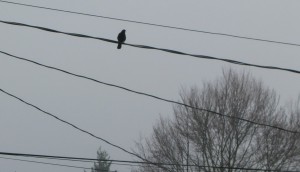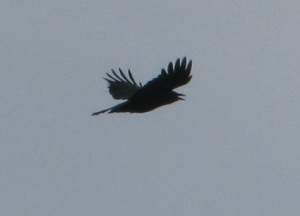NOPO SEASONINGS
Walking the same streets, from the first house to the last, in exactly the same sequence, day after day, for a decade now, it is the simple things I notice. The sights and sounds stand out in relief to the sheer redundancy of delivering the mail with nary a deviation. What does change are the elements, both inclement and sublime. Each season, every revolution around the sun, expands and constricts the ebb and flow of Nature, reminding me that these streets and houses did not always exist. This was pasture land across the plateau all the way to where the crest begins. Back then, there would have been a clear view to the mountains; the fire in their bellies still have a magnetic pull, despite being mostly obscured by rooftops.
Near the university’s entrance, I begin my route, hitting the streets about 9:15, just as off campus students are heading to first classes. I park my postal vehicle where once stood a large grove of walnut trees, only a few remaining once the houses were built. I am reminded of this each Fall when I hear a loud “thuwhack” ; the first time always surprising me, announcing as it does the changing season and a crow’s harvest, swooping down from telephone wire to snatch the walnut sweet meat from the shell just dropped from its beak, then swooping back up to perch on the wire to slowly eat it, while eyeing me, in my postal blue uniform and satchel, as a possible competitor. Crow eyes follow me as I make my first deliveries and head up Harvard St. towards Mocks Crest. As I turn right onto Willamette Blvd, snow capped Mt Hood hovers on the horizon to the left, shipyard cranes rise above the riverbank with the city skyline behind them, and Forest Park sleeps on its side with its head in Scappoose.
Most motorists, many of them Vancouver residents using the boulevard as a speedier alternative route to west side Portland, would be unaware that, eighty-five years ago, this was a peaceful lover’s lane; couples ambling arm and arm, or parking to cuddle and smooch and enjoy the city lights, and the planes taking off and landing at the airport below. That was back when Swan Island really was an island, but with the swans and eagles and the trees long since gone.
The crow, still perched on the telephone wire above my vehicle, hastily ascends as I turn back onto Fiske Ave. Soaring toward the river, banking on the air currents along the bluff, he follows the crest, gaining height until he is just a speck. Heading, perhaps, to the old growth trees circling Mock Mansion or Columbia Park.
Do crows tell tales of the past to their young? Bird’s eye views passed down through the years to baby crows? Life as seen on the peninsula as they nest, and feed, flying the air with swans, eagles, white & Grey Brant Ducks above the marshlands of what was then known as Willow Island, and later, Swan Island. Did they notice when the Swans stopped coming to nest there in 1922, anticipating that in 4 years the trees would be razed and the island surfaced in readiness of the building of Portland’s first commercial airfield. Did their crow ancestors fly alongside Charles Lindberg as he landed the “Spirit Of St Louis”, arriving to dedicate the new airstrip in 1927, so that humans could also fly? Bearing witness to humans raising homesteads and carving out streets, and darting about every which way in horse drawn wagons, river ferries, steamboats, steam powered trolleys, Jitney buses, the wartime shipyards and the building of Liberty and Victory ships. The chimney smoke of Woolen & Lumber Mills, the Ironworks and cooperages. The building of churches, schools and stores. Did they wonder at man’s folly at cutting down the grove of walnut trees?
As I move my vehicle from Harvard St to the next delivery loop at Yale, and then further on thru the morning to the streets of Amherst, Princeton, Syracuse, Depauw, Oberlin, and later in the day the avenues of Cambridge, University and Wellesley, it always reminds me of Pastor Al Cummings, who passed away a few years ago when his defibrillator could no longer keep his heart beating. It was he who first related to me a little of the history of this neighborhood called University Park. I deliver the mail to what was his church, University Baptist on Lombard, in the mornings. He once told me he could set his watch by my delivery, arriving much the same time every day. He’d stand at the curb, arms stretched outward, palms upward, staring straight ahead. Mock expectancy; it was our little ritual. And then later in the day, I would deliver the mail for him and his wife at their house. We got in the habit of trading historical anecdotes, after he learned I was interested in the history of the Mock house on Willamette Blvd., a glorious but dilapidated Queen Anne mansion, built in 1891. It was vacant at the time, and falling into such disrepair, that one wondered if the electrical wiring had become licorice for rats. A neighbor would grudgingly cut the grass when it got knee high, just so the bugs wouldn’t infest the area. The owner lived out of state and didn’t seem to give a damn about the slow dilapidation of a once stately home. Pastor Al and I commiserated on its sad decline.
As he was writing a history of his church and its congregation, he knew a little about the mansion and John Mock who built it on this hill with its wide view of the Willamette River and new city of Portland, only incorporated one year before. John and his parents arrived by way of the Oregon Trail in 1852, when he was thirteen. Through the Donation Land Claim program available to those willing to pioneer the region, father Henry obtained 317 acres that stretched along the crest all the way to Waud’s Bluff, where now the University Of Portland stands, and comprised most of the area now called University Park. To this day, the crest and the land just below it are referred to as Mock’s Crest and Mock’s Bottom. Over time, the acreage was sold off by descendants, with only the land upon which the house stands, with its expansive front lawn, remaining. The Columbia annex, which was given to the city for use as a park, used to be a large vegetable garden and Arboretum for the family. The house next door still has the in ground swimming pool that belonged to the Mock House. And the land behind the mansion, where it bordered Lombard (once called Jersey) St. was bequeathed to the Baptists to build their University Park Baptist Church in the 1960‘s, around the time that ownership of the Mock Mansion left the family.
The Methodist Church in 1891 purchased 600 acres of the pasture and rural farmland from Waud’s Bluff all the way to the Mock’s garden. 71 acres were set aside for the site of a Methodist college, to be called Portland University. The remaining land, to be known as University Park, was platted with the intention of selling lots as needed to fund the building and operating costs of the university. Much of it remained pasture land for years, however, due to the Panic of 1893, caused by shaky railroad finances and over building and subsequent bank failures; it was considered the worst economic collapse up until that time. As a result, 9 years after opening, the University had to close its doors. Later being purchased by the Roman Catholic Archdiocese of Portland first opening Columbia University in 1901, later changing its name to University Of Portland in 1935.
Later, when the University Park lots were finally sold, streets and houses were built, it was the layout as previously determined by the Methodist Church leaders in their plat maps as well as the names that had been given to those 51 streets finally being carved out of that pasture and farm land. Nineteen of the streets were named after well known universities and colleges; Berkeley, Oberlin, Cambridge, Stanford, Wellesley, Harvard, among them. The remaining names chosen were to honor various bishops, ministers,educators, famous authors and important layman well known in the nineteenth century, such as Dana, Hurst, Kimball, Olin, Wayland, Winchell. Interestingly, the direction of the streets were laid out running northeast-to-southwest and northwest-to-southeast, so that,at some point each day, every side of each house would face the sun.
It is on most of these same streets that I walk most of the year, through each season; all within a half mile of the University. While I deliver the mail to the people who live in the houses on these streets, I am left with my thoughts. Sorting the mail, and delivering it correctly to each house is certainly highly physical work but is not a complicated affair. If you see me out delivering the mail, in weather both inclement and sublime, I am always deep in thought. Sometimes I am creating a new recipe (as I used to be a chef), or working on a paragraph in my head for a writing project. Often I am whistling a tune (I have been called the whistling letter carrier at times), and always, as I hand the mail to these people, who are also my neighbors, we exchange a few brief words, no more than a sentence or two, that combined with all the other words shared over the last decade have become what I call The Dangling Conversation. This blog, then, contains some of those musings, and the story of some of those people (those who want them shared) and what history of this neighborhood I have learned over time from people like Pastor Al Cummings, and from Mr. Don Dinsmore, who also once lived on my route, having since passed on last September. He was curator of the University Of Portland’s Museum from its inception in 1984 to 2007. I also owe much to the writings of Jim Spiers, a self labeled amateur historian who tells many tales of North Portland in his column in the St John’s Review, many of which have since been compiled in book form. Much of my historical knowledge was gleaned from the publications and archives of the St Johns Historical Association.





Nice blog Steve! I enjoy your writing and feel like I was actually coming along on your route. Good luck with continuing observations